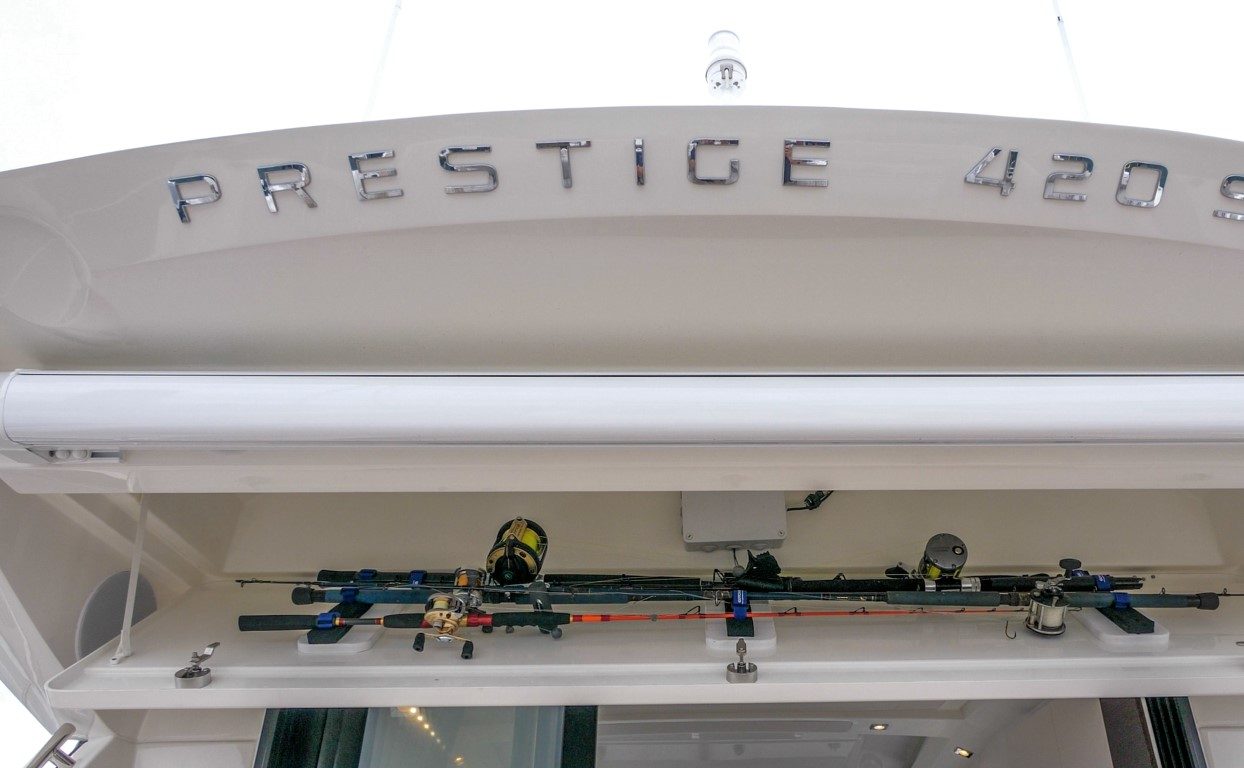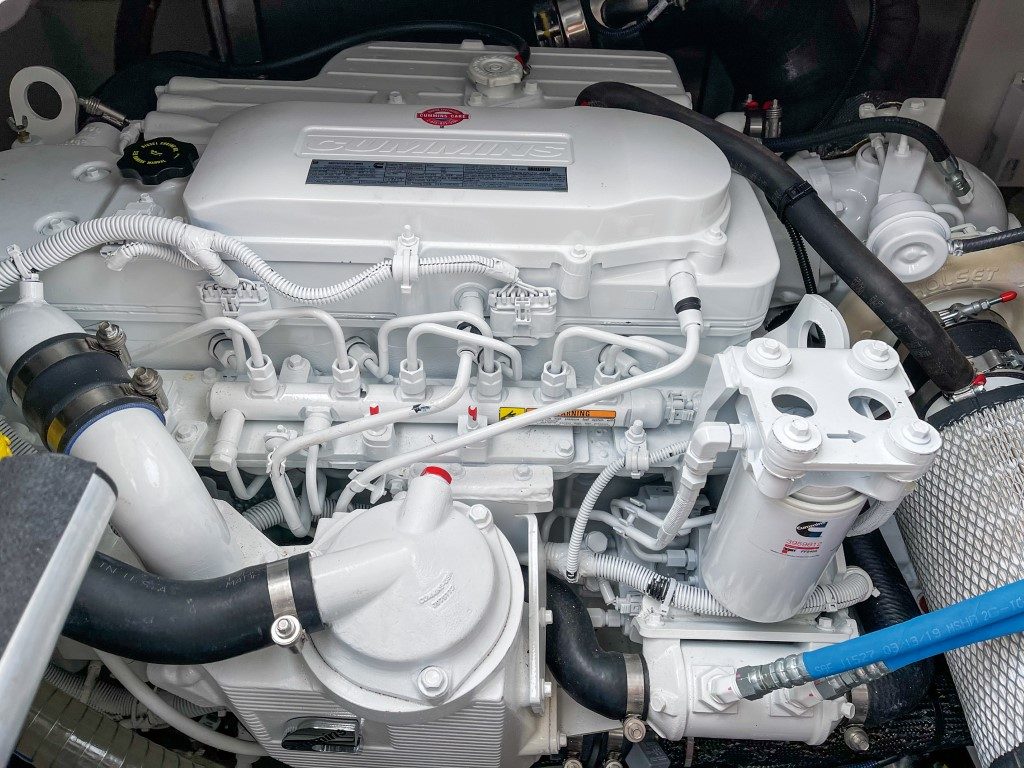She feels really easy and comfortable to sail, even in a good breeze and a chop.
- Full-beam master cabin midships
- Stylish single-level living
- Twin bathrooms
- Spacious interior
- Clean, modern decor
A sedan variant of the European Boat of the Year 2020, Brett and Averley Dennerly’s Wai Knot, the first Prestige 420s in New Zealand, has given them much joy since it arrived late last year.
The Prestige 420s is the sedan express version of the much-applauded flybridge motor yacht that was the darling of Europe’s boating press. But with more than 30 years’ experience with their own boats, which included two Rivieras, Brett and Averley knew they didn’t want a flybridge launch this time around.
Brett was adamant he was after a new, sedan-style launch to fit their existing marina berth, but a shaft-driven vessel rather than one with Volvo Penta’s IPS or stern drives. He likes the simplicity and lower maintenance costs of shaft drives. In addition, as a keen angler, he wanted to be able to take his boat close to shore without worrying about damaging the propellers. Shaft drives draw less water than IPS and Brett feels they are less susceptible to damage.

The smallest model in Prestige’s premium S-Line range, which now extends to the (new) 690s, the Prestige 420s – based on the open flybridge 420F – was new in 2020. The series was designed around Volvo Penta’s IPS, but along with the Prestige 590s, the 420s is now also offered in shaft drive, giving customers a slightly lower entry price and more choice.
Wai Knot’s Cummins QSB 6.7-litre 425hp engines are positioned under the cockpit sole, as they would be with IPS, but turning conventional shafts and props via V-drive gearboxes. The shaft-drive option is popular with Prestige customers, with 2020’s allocation quickly selling out. Wai Knot is the first shaft-drive Prestige in the southern hemisphere.
Brett and Averley saw the 420s at the Cannes Boat Show in 2019. They’d considered other vessels from a variety of manufacturers, but most were not available in shaft drive and the Prestige’s stunning full-beam master cabin really swung the deal. Until recently only offered on Jeanneau’s larger Prestige models, the 420s’s full-beam master sets it apart from its competitors in this size range.
The Dennerlys placed an order for a spec 420s through Orakei Marine and were assigned hull #32, complete with bow thruster and joystick upgrade.

They’re clearly very happy with their new vessel, which Brett reckons is more spacious than a Riviera 48. The boat’s hull is actually white gelcoat, but wrapped in grey vinyl, which looks stunning. The underwater portion is wrapped as well, using Flow Silicon material from NZMPS instead of antifouling paint. Flow Silicon provides superior slipperiness through the water and needs only occasional cleaning during its long service life. It comes with a 10-year warranty.
Outdoors
The 420s has an extra-wide swim platform (hydraulic lifting optional), which Orakei Marine has kitted out with its usual stainless steel U-shaped rail. This can be used to secure an inflatable tender and also supports the Orakei-supplied Kiwi-style bait station or a portable BBQ.
Orakei also paid attention to the vessel’s ground tackle, upgrading to a Rocna anchor with new chain and a Quick capstan with chain counter. The Dennerlys wanted gas cooking rather than electric, so Orakei took care of that too, supplying a stainless-steel gas bottle for the gas locker and also fitting numerous 12V outlets throughout the vessel. The owners have not opted for a genset.
The spacious aft platform is the obvious place for fishing, with a pull-out cockpit shower handy for swimmers wanting to rinse off the salt before stepping inside. The transom door is on the port side.

The teak-soled cockpit is a generous size, laid out for relaxing and entertaining. There’s plenty of storage under the L-shaped aft loungers, also accessible from the swim platform via transom lockers. A feature of this model is the electric awning that extends all the way to the transom, providing welcome shade and turning the cockpit into another room. Orakei has modified the large ceiling locker under the cockpit overhang to accommodate the Dennerly’s fishing rods, another ‘Kiwi’ touch.
Indoors
Since both zones are on the same level, the cockpit transitions seamlessly through sliding, stacking glass doors into the aft galley. A reasonably spacious engine room under the cockpit sole can be accessed either through a cockpit hatch or by lifting the galley floor. A poke around inside revealed neatly labelled wiring, tidy plumbing, fuel and engineering systems, with clean, easily-accessed bilges. The Dennerlys have fitted a Waeco freezer in the engine room for extra cold storage on extended cruises.
The galley is a good size with worktops along both sides. The sink and (gas) cooktop are to port, along with the under-bench oven, drawers and some cupboard storage. The fridge and drinks locker are under the bench opposite and the galley also has useful overhead lockers.

Wai Knot has the wenge timber upgrade, which looks very classy. The cabinetry and trim matches the laminated galley sole, but because the saloon interior is filled with light, the use of dark timber never feels oppressive. The contrast between wenge timber and bone-white leather upholstery with light-coloured ceiling panels/gelcoat works very well. There’s a pleasing simplicity to the interior decor, which comes across as modern and stylish.
The saloon is a great place to be. There’s a single step up from galley/cockpit level and carpet to demarcate the space. Seating on both sides offers good sight-lines through large side windows, through the windscreen, which benefits from relatively unobtrusive mullions, and aft through the open doors to the cockpit. The saloon table to port, also wenge, is the obvious focal point for socialising. It can be dropped to create an additional double berth in the saloon – window blinds provide privacy at night.

One of the reasons Brett wanted a single-level coupé style boat was to ensure he wasn’t isolated on the flybridge when travelling from place to place. With the 420s’s helm in the saloon, everyone shares the same level and Brett enjoys some company. On a fine day, opening the huge electric sunroof to let in the sky transforms the space, making it feel even bigger.
Below decks Wai Knot has a two-cabin, two-bathroom layout. That means the cabins and bathrooms are a generous size. In the bow the guest cabin has a king-size island berth, two large hanging lockers and plenty of built-in and under-bed storage. There’s lots of natural light from the windows and screened skylight/hatch, which also lets in fresh air. Air-conditioning is an option. Guests enjoy semi-ensuite access to the day head with its separate shower box and bright, easy-clean surfaces.
But it’s the smartly-styled, full-beam, midships master cabin under the saloon that sets the 420s apart. A midships master is a signature feature of the whole S-Line range, but seldom seen in vessels of this size. Although it lacks full headroom over the bed, the cabin certainly doesn’t lack for space.

The walk-around king-size bed is oriented fore and aft with a large screen TV occupying the forward bulkhead at the foot end of the bed. There’s generous built-in locker space under the cabin’s large windows, plus a bi-fold hanging locker with full standing headroom at the front of the cabin for dressing and accessing the ensuite bathroom. There’s also locker space for a washer-dryer, linen and towels.
Like the day head, the ensuite bathroom is practical and stylish in an understated kind of way, with a good-sized separate shower.
Averley had a hand in selecting the soft furnishings, working with Orakei Marine to select fabrics, colours and cushions from the factory’s a-la-carte menu, and also with Emma Harvey Gibbs (Cult Design) to furnish the boat with ornaments, linen, throws and pillows to give the boat its interior flair. And it all gels very well, imparting a sense of luxury that complements the vessel’s clean, modern European styling.

Going places
Although Brett admits he hasn’t yet completely mastered the Quick Shift joystick control, with his long experience he’s perfectly comfortable berthing the vessel using throttle controls alone. That said, the joystick integrates throttles and bow thruster to provide a level of precise low speed control that almost matches pod-drives.
Wai Knot’s helm station offers clear views across the foredeck and a drop-down side-window is handy when docking or shouting instructions to someone on the bow. The foredeck’s set up with European-style sun loungers with adjustable backrests and lots of drink holders. Cushions can be stowed if not required.
From the bucket-style pedestal helm seat, all the controls are within easy reach and the console is large enough to accommodate modern electronics. The Dennerlys opted for a Raymarine package, a pair of 12-inch multi-function displays, one purchased from the factory and a second one purchased here. Orakei Marine fitted both MFDs in New Zealand and took care of AIS, radar, sonar, GPS and video integration.
The autopilot is Raymarine, ex-factory, and the console also houses the Cummins digital display, anchor control, chain counter, trim tabs and various switches. The VHF is mounted to the side under the throttle controls.
Cummins QSB engines are electronic, as are the Quick Shift throttle controls, so shifting is effortless and quiet, with none of the clunks or thumps of older non-electronic systems. Syncing engine revs is also easy.

Wai Knot feels nimble and responsive. She climbs onto the plane smartly and rides level without too much trim tab input. High-speed turns are exhilarating without being alarming, since heel is well controlled, and the hull travels through the water smoothly. It was a dry runner on the day, but when it’s rough the windscreen wipers (with double motors and washers) should take care of any spray reaching the windscreen.
Fuel consumption is quite modest: we saw an indicated 41 litres per hour per engine at 18 knots and 51lph at 23 knots. Brett tends to cruise between 22 and 24 knots, dropping back a bit if he’s trying to conserve fuel. Top speed is right on 30 knots.
We were struck by how quiet the boat is underway. Engine noise is well suppressed – lifting the engine room hatch in the galley reveals some serious sound-proofing – while the hull is quiet through the water. We barely noticed any rattles and squeaks from the interior.

Prestige’s smallest S-Line model presents as a much bigger boat, which is exactly what attracted these experienced boaters. They now enjoy big boat features like a luxurious mid-cabin master and spacious single-level living, all cleverly bundled into a compact, easy-to-handle, shaft-driven package.
Wai Knot indeed?/>
She feels really easy and comfortable to sail, even in a good breeze and a chop.
At first glance the boat appears to be a large centre console, although hidden beneath the console and forward area is a sizeable overnight cabin.
With classic styling, good performance and class-leading ride and handling, there’s a lot to like about the Caribbean 32.
Solar panels on the vast roof help keep the batteries charged.